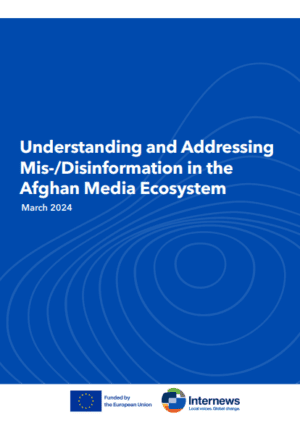This report summarizes Internews’ six-month social media monitoring research conducted in 2023 that aimed to better understand the online mis- and disinformation environment in Afghanistan.
The research was conducted in two phases. The first phase focused on identifying and analysing the themes and narratives in Afghanistan’s online mis- and disinformation. This involved studying the sources, nature, and spread of false and misleading information in the Afghan digital media ecosystem. In the second phase, the research turned to the role of journalists and media outlets and sought to understand how journalistic practices and challenges can contribute to the spread of false news. A comprehensive verification process was employed, including source and author verification, cross-referencing and evidence checks, content analysis, narrative assessment, journalistic standards check, and context/completeness check.
The first phase of the study revealed key aspects of Afghanistan’s digital information landscape. The research found four common narratives around mis- and disinformation including the Taliban/Taliban de facto authorities’ threat to human and minority rights, loss of self-rule, the Taliban de facto authorities’ legitimacy as a governing body, and opposition to their governance. Most of the associated mis- and disinformation associated with these narratives originated from the Afghan diaspora.
The research also found a gender imbalance in the digital discourse, with male-dominated discussions and limited female participation. Gender narratives on social media are mostly driven by men, often portraying women passively, and include disinformation tactics by the Taliban de facto authorities, such as falsely showing women’s support for oppressive policies.
Anti-Taliban sentiments included former government figures who significantly shape digital discourse and contribute to spreading disinformation including exaggerations or fabrications of the authorities’ actions. However, alongside anti-Taliban sentiments, there was a notable pro-Taliban commentary endorsing their governance and presenting them in favourable ways.
Our findings for the second phase reveal several troubling trends. Many news stories feature clickbait or misleading headlines that don’t align with the actual content. A significant problem is the presentation of unverified information as fact, which fosters public mistrust. Approximately 40% of false news stories lack sources, and over half rely on just a single source, affecting the depth and reliability of reporting. Additionally, there is a tendency to use sensational headlines and emotionally charged content to increase engagement, often sacrificing factual accuracy. The rapid spread of misinformation is also facilitated by exploiting audience behaviours on social media. Afghan media, particularly those dependent on donor funding, struggle to balance accurate reporting with the need for high audience engagement. Complex reporting dynamics in Afghanistan include protecting sources, relying on second-hand information, and the difficulty of verifying claims made on social media. While some media outlets endeavour to use diverse sources, the challenges of fact verification and maintaining reporting integrity persist.
The report recommends establishing fact-checking initiatives, promoting digital literacy, and ethical journalism practices. For media outlets, transparency, audience engagement, and balance are key. Meanwhile, donors should prioritize funding for independent media, invest in technology, and support capacity building and collaborative reporting initiatives.
